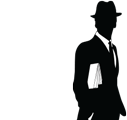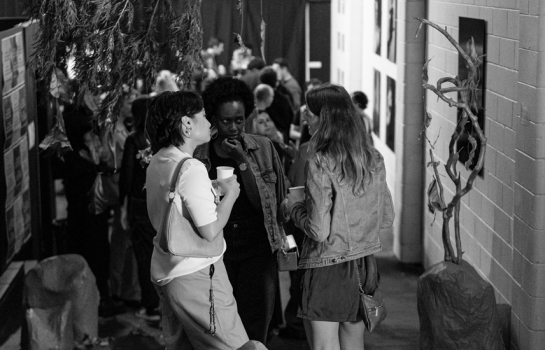José Da Silva, senior curator and head of Australian Cinémathèque, QAGOMA
Audiences will be surprised by how wide-ranging David Lynch’s studio practice is ...
David Lynch is a man shrouded in mystery. From the silver crests of his hair to the absurd themes in his work, the man is stylish, contemporary and always original. Alongside his career as a director and producer, David has also spent decades channelling his creativity into visual art, photography and music. Next week, the Gallery of Modern Art will unveil an Australian-first exhibition David Lynch: Between Two Worlds, which dishes up an exclusive 50-year retrospective of the legend’s work. Before David comes to Brisbane for the opening-night party next Friday March 13, The Weekend Edition chatted to QAGOMA senior curator and head of Australian Cinémathèque, José Da Silva, about the most controversial pieces in the exhibition.
The countdown is on until David Lynch: Between Two Worlds opens at GOMA on Saturday March 14. What can visitors expect to see at the exhibition?
There’s so much to see, hear and do with this exhibition! The show comprises more than 200 art works across a seven-gallery space, a film retrospective at the Australian Cinémathèque, a resource lounge dedicated to David’s music and some very special events, including two concerts based on the music of Twin Peaks by one of my favourite bands, Xiu Xiu. Inside the exhibition, audiences can expect to have pretty memorable experience. You’ll have the chance to walk through the limits of a drawing and encounter some remarkable images and objects – the remnants of smokestack industry, bodies distorted and things decaying, nightmarish scenes from the everyday and some incredibly whacky lamps. And that’s just the first three rooms!
You worked directly with David himself in developing this project – what can you tell us about the man behind the myth?
He’s a very generous and thoughtful man and one of the hardest working artists I’ve had the pleasure of meeting. Ideas are everything for David, and he’s got plenty of them!
For those of our readers who aren’t familiar with David’s work, how would you describe it?
I think audiences will be surprised by how wide-ranging David’s studio practice is. He works across a wide variety of media – from painting, drawing, photography and printmaking to industrial design, sound, music and video. While he reaches into some of the darker parts of the human psyche, his work always also has a good sense of absurd humour. Audiences will recognise a certain mood and atmosphere from his films where there’s a fear in the air or something miraculous in the mundane. David says we’re all detectives in this life and that we’re always looking for answers to the mysteries. His work is filled with mysteries and they offer little glimpses at the answers, which keeps us searching for more.
What’s your personal favourite piece in the retrospective?
I have lots of favourites, including two large chalk drawings from 1987 that I discovered in David’s garage; a small text-based lithograph called Dark Deep Darkness (2009) that describes the splendour of nighttimes; and a suite of 25 matchbooks with intricate drawings in their folds. But most of all, there’s a 55-second film called Premonitions Following an Evil Deed (1996) that I find absolutely compelling. It’s one of the most unsettling and beautiful works in the show. David made the short film using an original Lumière Brothers camera and it’s composed of brief glimpses of something haunting and unexplained.
David is known for pushing the boundaries – what are some of the more controversial works in this collection?
One work that seems to strike a nerve with audiences is the absurd comedy Dumbland (2002). It’s a series of short animations that depict the explosive anger of a man in his suburban home. He’s a really gross archetype of masculine agro and spends each episode exerting his will over others. It’s abrasive, crude, but also very funny because of its absurdity.
American artist Chrysta Bell will be performing at the opening-night party on Friday March 13. What should guests expect from David’s current muse?
Chrysta has a commanding presence and when she sings, you just drift into a perfect dream. She wrote her first album This Train with David at his home studio over a 10-year period and it’s a mix of sensuous guitars and synths and smoky vocals. It’s the type of music you’d expect to hear at the Twin Peaks Roadhouse bar today. Chrysta is making a special trip to Brisbane to perform at the opening and it’s going to be a special gig. We’ve made a special allocation of tickets available to the public, so don’t miss out!
What does your role as senior curator and head of Australian Cinémathèque at QAGOMA involve?
I oversee the gallery’s curatorial department dedicated to film, video and new media, which include curators and technical staff. The department curates all the cinema programs presented in the Cinémathèque, along with a range of exhibitions and performances. I’ve been working in this department since its inception and it’s incredible to think that we’ve screened something like 4000 films for Brisbane audiences since 2006!
You were an artist before you moved into curating. What can you tell us about your creations?
I used photography, video, sound and installation to explore violence and sexuality and was really big on re-photographic procedures. I haven’t stopped making art altogether, just recalibrated the way it figures into my professional life. There’s not enough time and space to be an artist and curator effectively, so nowadays I just make stuff myself. It’s mostly naff stuff about internet crushes.
When did you turn to curating?
I made inroads during art school, but only really considered it as a ‘practice’ when I completed my postgrad. I’ve since worked on number of different types of curatorial projects, working across cinema, new media and contemporary art. The exhibition that perhaps best articulates why I became a curator is a small exhibition I did for Gertrude Contemporary’s Octopus series. I saw curating as a way to tell these types of stories that are invested in the way we reconcile memory.
What’s one piece of art that really moved you?
There’s a work by Roni Horn about the artist Félix González-Torres and his partner Ross Laycock that overwhelms me each time I encounter it. It’s called Paired Gold Mats — for Ross and Felix (1994–95) and consists of two sheets of pure gold leaf lying on top of each other. It’s about the precious and fragile nature of relationships. I’ll never forget the first time I saw this work at the Collection Lambert in Avignon. It was installed without much fuss on a concrete floor and illuminated by the smallest amount of sunlight from a nearby window. I literally burst into tears when I saw it.
What other upcoming QAGOMA exhibitions should we mark in our calendars?
My colleague Bruce McLean is preparing a major retrospective honouring the life and work of Mirdidingkingathi Juwarnda (Mrs Gabori) that opens in 2016. Gabori was one of Australia’s most affecting painters and Bruce is such a sensitive and talented curator. I have a feeling this is going to be one of the most beautiful shows QAGOMA does in the next few years.
What are the challenges and rewards for a curator?
The biggest challenge for me is finding a balance between work and life, as the divisions are never quite so clear for arts workers. Independent curators also face the very real challenge of money and spaces to present exhibitions. The rewards, though, are constant, especially in the ability to work collaboratively every day with a range of creative professionals and devote time to research and learning. I always describe what I do as ‘exhibition making’ – the artists are the source and it’s a pleasure to help them realise their exhibitions!
What’s one of the best pieces of advice you’ve ever received or given?
My friend Debra once told me that the artist Annette Messager would always say that ‘art should make life more interesting than art’. Also, my grandmothers were both big on encouraging my intuition and I’ve stuck to that – especially with this exhibition.
What are your words of wisdom for young local creatives?
Leave Brisbane if you can and gain some perspective from elsewhere. Then come back and help make this city something special!
Only a Brisbane local would know that … the real Chinatown is in Sunnybank.
FAVOURITE WEEKEND SPOT TO:
Perk up … running along the New Farm/Teneriffe Riverwalk and an afternoon spritzer at Jamie’s Espresso Bar, Fortitude Valley.
Dine … the big breakfast at Campos, Fortitude Valley; the lunch sandwich special at Pearl Cafe, Woolloongabba; and some supper at Julius, South Brisbane.
Indulge … beer and biltong at Green Beacon Brewing, Teneriffe, or an afternoon trawling Tumblr.
Be inspired … The Saturday Paper, Radio National and Astrobarry’s weekly horoscopes.


